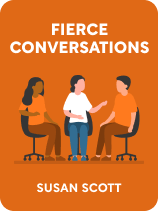

This article is an excerpt from the Shortform book guide to "Fierce Conversations" by Susan Scott. Shortform has the world's best summaries and analyses of books you should be reading.
Like this article? Sign up for a free trial here.
What are Fierce Conversations’ models for truthful discussions? How can you have a productive conversation in small and large groups?
In Fierce Conversations, Susan Scott explains that you must choose an effective conversational model to structure important discussions. Following a conversational model is crucial because it allows you to respectfully introduce the topic and learn from all perspectives.
Below are two models from Fierce Conversations that you can use for small groups or large meetings.
Model #1: Conversing in Small Groups
The first Fierce Conversations model is intended to be used for intimate conversations with one or a few people and can be used in personal or corporate situations. Its purpose is to find the root of an issue and surface effective and sustainable solutions by uncovering other peoples’ truths—the thoughts, feelings, and perspectives that are important to the topic but that participants may be hesitant to acknowledge and discuss. To structure your discussion according to this model, take the following steps:
Step #1: Succinctly Explain the Issue
Your opening statement must be succinct while providing the necessary details for the other person to fully understand the issue. You should express your desire to discuss the topic, provide an example to illustrate the issue, explain how it’s impacting you emotionally and why the issue is important, acknowledge any role you’ve played in the issue, and express your desire to solve it.
For example, “I’d like to talk about your mental health. You seem very emotional lately—for example, when you yelled at me yesterday for forgetting to buy milk. That startled me and made me feel guilty, and I think this issue has the potential to create distance between us and damage our relationship if it continues. I acknowledge that I might be playing a role in this issue by not being as thoughtful lately, and I want to try and come to a solution so we can make sure you’re feeling mentally healthy and happy.”
Step #2: Ask for the Other Person’s Perspective
Once you’ve explained the issue you want to discuss, invite others into the conversation by asking them to share their perspective on the issue—what the issue is, how it’s impacting them, and what they think might be at stake. You can start with a question like, “Can you tell me more about your perspective on this topic and what might be going on with your mental health right now?” If they provide vague responses, you can directly ask them the questions to define the issue and its importance.
Then, clarify their perspective by asking for further details on their thoughts and feelings—why do they think the issue is happening, what role do they play in the issue, what’s their ideal outcome, and what actions do they think will be most effective in achieving that outcome? Ask them to elaborate on any thoughts, statements, or feelings that you don’t understand. Scott emphasizes that you should only ask questions and clarify their responses during this time—don’t interject with your own statements.
Step #3: Resolve the Issue
Discuss what each party has learned about each other’s truths during the discussion and consider whether there’s anything left that needs to be discussed or clarified to find a solution. Then, identify what needs to be done to resolve the issue and how to hold each person accountable. For example, maybe your friend needs to talk about her mental health, so she’ll schedule appointments with a therapist once a week to take accountability.
Model #2: Conversing in Large Groups
Scott’s second model, designed for group meetings in corporate settings, intends to uncover all important details and perspectives of complex issues. This is important because organizations are multifaceted—individuals will have different perspectives on issues based on their location, role, level of authority, and so on. If each of these perspectives isn’t exposed, important details may be overlooked, which could result in poor solutions.
To structure your discussion according to this model, Scott provides the following guidelines:
Step #1: Invite Your Participants
In your invitation, brief these people on the topic to save time during the meeting—define the issue and its importance, and explain what their role is in the meeting. You can also include any background information that they should know before the meeting.
Step #2: Open the Meeting
First, remove all distractions—no electronics, multitasking, or note-taking. Then, verbally review your topic preparation, and pass out paper copies to attendees once you’re done.
Step #3: Open the Floor
Invite people to ask clarifying questions. Then, request that they perform the role you requested in the invitation—providing information, feedback, advice, and so on. Ensure everyone in the meeting speaks, and directly request input from those who don’t speak up.
Step #4: Close the Meeting
Have everyone write down how they’d handle the situation if they were you and share their answer aloud. Afterward, summarize the feedback you received, and ask if you forgot anything. Thank everyone for participating.

———End of Preview———
Like what you just read? Read the rest of the world's best book summary and analysis of Susan Scott's "Fierce Conversations" at Shortform.
Here's what you'll find in our full Fierce Conversations summary:
- Why you must have uncomfortable discussions about feelings
- How to uncover the most critical issues that must be addressed
- How to ensure you stay aligned with your life goals






